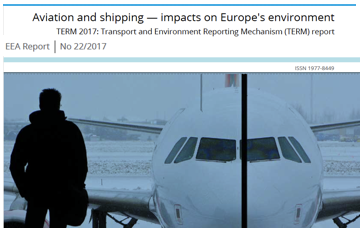Aviation and shipping – impacts on Europe’s environment TERM 2017
j F Y in In Evidenza
Aviation and shipping — impacts on Europe’s environment.
TERM 2017: Transport and Environment Reporting Mechanism (TERM) report
TERM 2017 — A focus on aviation and shipping Domestic and international aviation and shipping are key components of Europe’s mobility system. They are both economic sectors that directly bring many societal and economic benefits, such as the delivery of a wide range of goods and services and provision of employment and mobility for personal, leisure or business purposes. However, from a broader environmental perspective, both sectors are also seen as challenging, as increasing demand is leading to increased pressures on the environment and climate. The joint consideration of aviation and shipping in the year 2017 report reflects key similarities — opportunities and challenges — between the two economic sectors. These similarities include: • International rather than local factors are largely responsible for the significant transport demand from these modes, for example driven by the globalisation of trade.
• Demand in these sectors is often led by consumers through tourism and the global supply chain of certain types of food and manufactured goods.
• The sectors have environmental impacts. They are responsible for a growing proportion of greenhouse gas (GHG) emissions, as well as contributing significantly to regional and local air pollution, noise pollution, pressure on land resources, water, etc.
• Mitigation actions are mainly regulated at the global rather than European or national levels. • Robust monitoring and verification of air pollutant and GHG emissions from aviation and shipping, Executive summary particularly measuring actual emissions under real‑life conditions, are challenging at present.
• These sectors have similar approaches towards governance, with both aviation (airports) and the maritime sector (ports) based around specific hubs, each of which requires efficient connection to secondary logistical and transport connections.
Expected economic growth and higher emissions set the aviation and shipping sectors apart from other economic sectors, which have seen reductions in GHG, air and water pollutant emissions in many regions since 1990. Demand has increased rapidly at the global and European levels for both freight and passenger transport. Driving forces underpinning this demand include the growing globalisation of trade, economic and population growth and an increase in average wealth.







